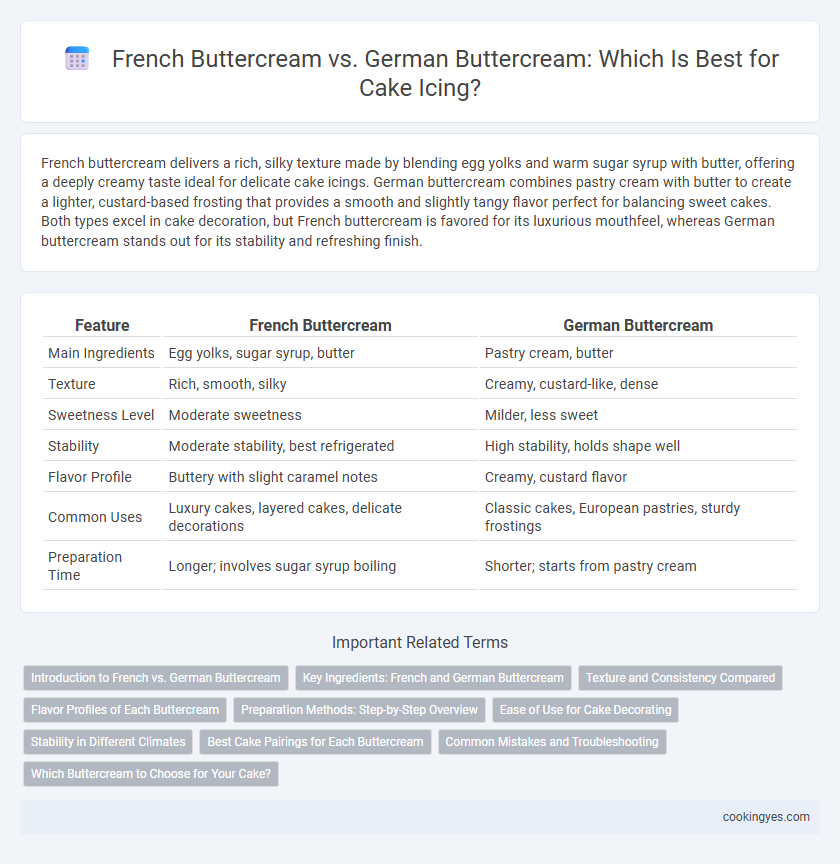French buttercream delivers a rich, silky texture made by blending egg yolks and warm sugar syrup with butter, offering a deeply creamy taste ideal for delicate cake icings. German buttercream combines pastry cream with butter to create a lighter, custard-based frosting that provides a smooth and slightly tangy flavor perfect for balancing sweet cakes. Both types excel in cake decoration, but French buttercream is favored for its luxurious mouthfeel, whereas German buttercream stands out for its stability and refreshing finish.
Table of Comparison
| Feature | French Buttercream | German Buttercream |
|---|---|---|
| Main Ingredients | Egg yolks, sugar syrup, butter | Pastry cream, butter |
| Texture | Rich, smooth, silky | Creamy, custard-like, dense |
| Sweetness Level | Moderate sweetness | Milder, less sweet |
| Stability | Moderate stability, best refrigerated | High stability, holds shape well |
| Flavor Profile | Buttery with slight caramel notes | Creamy, custard flavor |
| Common Uses | Luxury cakes, layered cakes, delicate decorations | Classic cakes, European pastries, sturdy frostings |
| Preparation Time | Longer; involves sugar syrup boiling | Shorter; starts from pastry cream |
Introduction to French vs. German Buttercream
French Buttercream is made by whipping egg yolks with sugar syrup and then incorporating butter, resulting in a rich, creamy texture ideal for delicate cakes. German Buttercream, on the other hand, combines pastry cream with butter, offering a thicker, custard-like consistency that provides stability and intense flavor. Both types of buttercream have unique preparation methods and textures, influencing their suitability for various cake designs and taste preferences.
Key Ingredients: French and German Buttercream
French buttercream relies heavily on egg yolks and sugar syrup, creating a rich, custard-like base that is then whipped with butter for a creamy texture. German buttercream combines pastry cream with softened butter, resulting in a smooth, stable frosting with a balanced sweetness. The key difference lies in French buttercream's emphasis on egg yolks and sugar syrup versus German buttercream's use of pastry cream as the foundational ingredient.
Texture and Consistency Compared
French buttercream offers a rich, silky, and smooth texture due to its egg yolk and butter base, creating a luxurious mouthfeel ideal for delicate cake finishes. German buttercream combines pastry cream and butter, resulting in a thicker, denser consistency with a slightly custard-like firmness that holds shape better in warm conditions. Texture-wise, French buttercream is lighter and creamier, while German buttercream provides a more stable, substantial icing ideal for structured decorations.
Flavor Profiles of Each Buttercream
French buttercream features a rich, custardy flavor derived from egg yolks and sugar syrup, offering a smooth and creamy texture with a subtle sweetness ideal for delicate cake flavors. German buttercream combines pastry cream and butter, resulting in a denser, creamier consistency with a pronounced vanilla or custard taste, providing a luxurious and buttery richness. The choice between French and German buttercream depends on whether a lighter, silkier finish or a more robust, creamy icing is desired for the cake.
Preparation Methods: Step-by-Step Overview
French buttercream preparation involves whisking egg yolks and sugar over gentle heat until thickened, then incorporating softened butter to achieve a rich, silky texture. German buttercream combines a custard base made from milk, sugar, and cornstarch or flour, which is cooked and cooled before folding in butter for a creamy consistency. Both methods require precise temperature control and thorough mixing to ensure smooth, stable icing ideal for cake decoration.
Ease of Use for Cake Decorating
French buttercream offers a rich and creamy texture but requires precise temperature control, making it slightly challenging for novice decorators. German buttercream, made with custard base, is more stable and easier to handle, allowing smoother application and better hold for intricate cake designs. Both types provide excellent flavor, but German buttercream is generally favored for ease of use in detailed cake decorating.
Stability in Different Climates
French buttercream, made from egg yolks and butter, offers a rich texture but tends to be less stable in warm or humid climates due to its lower butter content and higher sensitivity to temperature changes. German buttercream, which incorporates pastry cream and butter, provides better resilience and maintains its structure more effectively in varying environmental conditions, making it a preferred choice in hotter regions. Stability under different climates is crucial for cake icing, where German buttercream's moisture-retentive properties help prevent melting and collapse.
Best Cake Pairings for Each Buttercream
French buttercream, made with egg yolks, sugar syrup, and butter, pairs excellently with delicate sponge cakes like genoise or chiffon, enhancing flavors without overpowering. German buttercream, a blend of butter and custard, complements denser cakes such as chocolate or coffee-flavored cakes, providing a rich and creamy contrast. Each buttercream's texture and sweetness balance well with specific cake types, optimizing taste and mouthfeel in cake layering and decorating.
Common Mistakes and Troubleshooting
French Buttercream often suffers from curdling due to egg yolk overheating, while German Buttercream can become too runny if the custard base lacks proper thickening. Common mistakes include whipping French Buttercream too vigorously, causing separation, and overheating German Buttercream custard, leading to grainy texture. Troubleshooting involves maintaining precise temperatures for egg custards and gradually incorporating butter at room temperature to ensure smooth, stable icing.
Which Buttercream to Choose for Your Cake?
French buttercream offers a rich, custard-based texture with egg yolks and sugar syrup, delivering a silky and luxurious finish ideal for delicate sponge cakes. German buttercream combines pastry cream and butter, providing a thicker, creamier consistency that holds well in warm environments and pairs perfectly with dense cakes. Choosing between the two depends on your cake's flavor profile and texture, with French buttercream suiting lighter cakes and German buttercream best for robust cakes needing stable, long-lasting icing.
French Buttercream vs German Buttercream for cake icing Infographic

 cookingyes.com
cookingyes.com